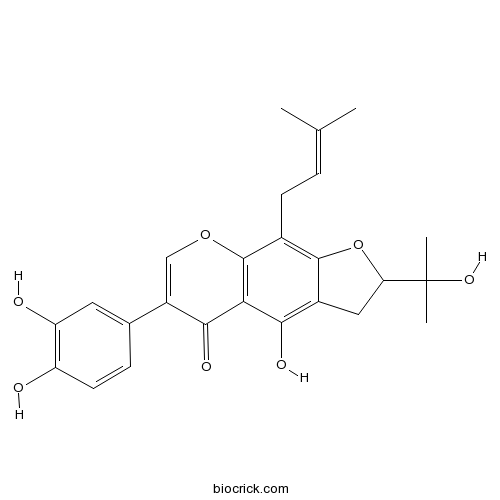Furowanin ACAS# 911004-72-3 |

Quality Control & MSDS
3D structure
Package In Stock
Number of papers citing our products

| Cas No. | 911004-72-3 | SDF | Download SDF |
| PubChem ID | 11582970 | Appearance | Powder |
| Formula | C25H26O7 | M.Wt | 438.5 |
| Type of Compound | Flavonoids | Storage | Desiccate at -20°C |
| Solubility | Soluble in Chloroform,Dichloromethane,Ethyl Acetate,DMSO,Acetone,etc. | ||
| Chemical Name | 6-(3,4-dihydroxyphenyl)-4-hydroxy-2-(2-hydroxypropan-2-yl)-9-(3-methylbut-2-enyl)-2,3-dihydrofuro[3,2-g]chromen-5-one | ||
| SMILES | CC(=CCC1=C2C(=C(C3=C1OC=C(C3=O)C4=CC(=C(C=C4)O)O)O)CC(O2)C(C)(C)O)C | ||
| Standard InChIKey | NMEQUFXTRAXRGN-UHFFFAOYSA-N | ||
| Standard InChI | InChI=1S/C25H26O7/c1-12(2)5-7-14-23-15(10-19(32-23)25(3,4)30)21(28)20-22(29)16(11-31-24(14)20)13-6-8-17(26)18(27)9-13/h5-6,8-9,11,19,26-28,30H,7,10H2,1-4H3 | ||
| General tips | For obtaining a higher solubility , please warm the tube at 37 ℃ and shake it in the ultrasonic bath for a while.Stock solution can be stored below -20℃ for several months. We recommend that you prepare and use the solution on the same day. However, if the test schedule requires, the stock solutions can be prepared in advance, and the stock solution must be sealed and stored below -20℃. In general, the stock solution can be kept for several months. Before use, we recommend that you leave the vial at room temperature for at least an hour before opening it. |
||
| About Packaging | 1. The packaging of the product may be reversed during transportation, cause the high purity compounds to adhere to the neck or cap of the vial.Take the vail out of its packaging and shake gently until the compounds fall to the bottom of the vial. 2. For liquid products, please centrifuge at 500xg to gather the liquid to the bottom of the vial. 3. Try to avoid loss or contamination during the experiment. |
||
| Shipping Condition | Packaging according to customer requirements(5mg, 10mg, 20mg and more). Ship via FedEx, DHL, UPS, EMS or other couriers with RT, or blue ice upon request. | ||
| Description | 1. Furowanin A shows significant cytotoxicity against HL-60 cells. 2. Furowanin A induces that Caspase-9 and caspase-3 inhibitors suppresses apoptosis. |
| Targets | Caspase |

Furowanin A Dilution Calculator

Furowanin A Molarity Calculator
| 1 mg | 5 mg | 10 mg | 20 mg | 25 mg | |
| 1 mM | 2.2805 mL | 11.4025 mL | 22.805 mL | 45.61 mL | 57.0125 mL |
| 5 mM | 0.4561 mL | 2.2805 mL | 4.561 mL | 9.122 mL | 11.4025 mL |
| 10 mM | 0.2281 mL | 1.1403 mL | 2.2805 mL | 4.561 mL | 5.7013 mL |
| 50 mM | 0.0456 mL | 0.2281 mL | 0.4561 mL | 0.9122 mL | 1.1403 mL |
| 100 mM | 0.0228 mL | 0.114 mL | 0.2281 mL | 0.4561 mL | 0.5701 mL |
| * Note: If you are in the process of experiment, it's necessary to make the dilution ratios of the samples. The dilution data above is only for reference. Normally, it's can get a better solubility within lower of Concentrations. | |||||

Calcutta University

University of Minnesota

University of Maryland School of Medicine

University of Illinois at Chicago

The Ohio State University

University of Zurich

Harvard University

Colorado State University

Auburn University

Yale University

Worcester Polytechnic Institute

Washington State University

Stanford University

University of Leipzig

Universidade da Beira Interior

The Institute of Cancer Research

Heidelberg University

University of Amsterdam

University of Auckland

TsingHua University

The University of Michigan

Miami University

DRURY University

Jilin University

Fudan University

Wuhan University

Sun Yat-sen University

Universite de Paris

Deemed University

Auckland University

The University of Tokyo

Korea University
- 3,6,19,23-Tetrahydroxy-12-ursen-28-oic acid
Catalog No.:BCN1310
CAS No.:91095-51-1
- 8-Epidiosbulbin E acetate
Catalog No.:BCN7812
CAS No.:91095-48-6
- Danshenol C
Catalog No.:BCN6681
CAS No.:910856-25-6
- BAY 60-6583
Catalog No.:BCC6197
CAS No.:910487-58-0
- RGDS peptide
Catalog No.:BCC7694
CAS No.:91037-65-9
- CGI-1746
Catalog No.:BCC1473
CAS No.:910232-84-7
- Impurity of Calcipotriol
Catalog No.:BCC5388
CAS No.:910133-69-6
- Fmoc-Arg-OH
Catalog No.:BCC3039
CAS No.:91000-69-0
- N,N'-Bis(acetoacetyl)-o-toluidine
Catalog No.:BCC9062
CAS No.:91-96-3
- Benzoguanamine
Catalog No.:BCC8853
CAS No.:91-76-9
- Coumarin
Catalog No.:BCN6309
CAS No.:91-64-5
- Syringol
Catalog No.:BCN3534
CAS No.:91-10-1
- Isotussilagine
Catalog No.:BCN1985
CAS No.:91108-32-6
- SB 706504
Catalog No.:BCC5615
CAS No.:911110-38-8
- Adapalene sodium salt
Catalog No.:BCC4285
CAS No.:911110-93-5
- Cefoselis hydrochloride
Catalog No.:BCC4093
CAS No.:911212-25-4
- LY2603618
Catalog No.:BCC3923
CAS No.:911222-45-2
- MPP dihydrochloride
Catalog No.:BCC7225
CAS No.:911295-24-4
- EC 144
Catalog No.:BCC5600
CAS No.:911397-80-3
- SLx-2119
Catalog No.:BCC1954
CAS No.:911417-87-3
- Infractin
Catalog No.:BCN3652
CAS No.:91147-07-8
- Terbinafine
Catalog No.:BCC3865
CAS No.:91161-71-6
- 17-AAG Hydrochloride
Catalog No.:BCC1297
CAS No.:911710-03-7
- Chrysothol
Catalog No.:BCN4454
CAS No.:911714-91-5
Induction of apoptosis by isoflavonoids from the leaves of Millettia taiwaniana in human leukemia HL-60 cells.[Pubmed:16557456]
Planta Med. 2006 Apr;72(5):424-9.
We have isolated two new isoflavonoids, millewanin-F (1) and furowanin-A (2), together with five known isoflavonoids from the leaves of Millettia taiwaniana Hayata (Leguminosae) and examined their effects on the growth of human leukemia HL-60 cells. Among the isolated isoflavonoids, furowanin-A (2), warangalone (3), isoerysenegalensein-E (4), and euchrenone b10 (6) showed significant cytotoxicity against HL-60 cells. After treatment with three of the cytotoxic isoflavonoids, furowanin-A (2), warangalone (3), and isoerysenegalensein-E (4), fluorescence microscopy with Hoechst 33,342 staining revealed that the percentage of apoptotic cells with fragmented nuclei and condensed chromatin increased in a time-dependent manner. In addition, the activities of caspase-9 and caspase-3 were also enhanced in a time-dependent manner upon treatment with the isoflavonoids 2, 3, and 4. Caspase-9 and caspase-3 inhibitors suppressed apoptosis induced by isoflavonoids 2, 3, and 4. These results suggest that the isoflavonoids induced apoptosis in HL-60 cells through activation of the caspase-9/caspase-3 pathway, which is triggered by mitochondrial dysfunction.


